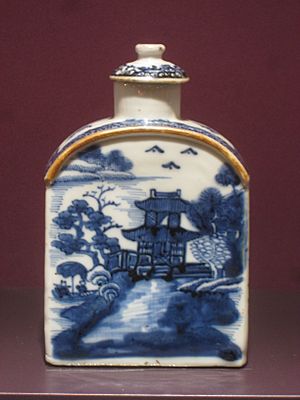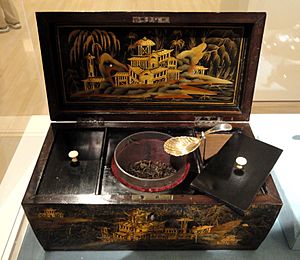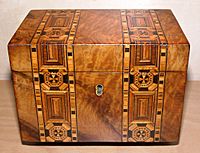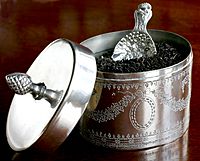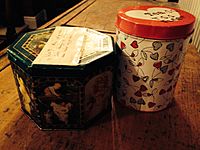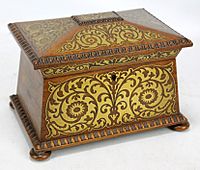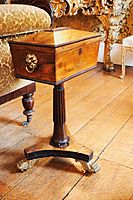Tea caddy facts for kids
A tea caddy is a special container used to keep tea fresh and safe. When tea first came to Europe from Asia, it was very costly. People often kept their tea caddies locked up! These containers were usually fancy and beautiful. They matched the furniture in important rooms like a living room. Hot water was brought from the kitchen. The lady of the house would then make the tea herself or watch someone else do it.
The name "caddy" probably comes from "catty". This was a Chinese measurement, like a pound. The first tea caddies in Europe were made of Chinese porcelain. They looked a lot like ginger-jars. These early caddies had Chinese-style lids and were often blue and white. Before the year 1800, people usually called them "tea canisters."
How Tea Caddies Changed Over Time
At first, English makers copied the Chinese designs. But soon, they started creating their own unique shapes and decorations. Many ceramic factories in England competed to make these new, fashionable items. The earliest tea caddies were made from porcelain or a type of pottery called faience. Later, caddies were made from many different materials.
Materials Used for Caddies
People used wood, pewter, tortoiseshell, brass, copper, and silver. But wood was the most common material. Many wooden caddies from the Georgian period still exist today. These were often made from beautiful woods like mahogany, rosewood, and satin-wood. They often had brass decorations and delicate inlay designs. Their small handles were made of ivory, ebony, or silver.
Many tea caddies were also made in Holland, especially from the pottery of Delft. English factories also produced many high-quality caddies. Soon, Western designs were even copied in Chinese export porcelain and Japanese porcelain. A special tool called a caddy spoon was often used with them. This spoon was usually silver and shaped like a wide shovel. It was perfect for scooping tea.
From Jars to Boxes
As tea caddies changed from jars to boxes, people stopped using separate containers for green and black tea. Wooden tea chests or caddies became popular. These boxes had a lid and a lock. They often had two or three sections inside. The outer sections held the tea, and the middle part was usually for sugar.
In the late 1700s and early 1800s, caddies made from mahogany and rosewood were very popular. The Chippendale company made caddies in a fancy style called Louis Quinze. These had special claw-and-ball feet and beautiful finishes. The wooden caddies had rich designs and simple, delicate inlay. They looked graceful and fit in well. Some even looked like tiny sarcophagi (ancient stone coffins). These had small claw feet and brass rings, and people thought they were charming.
The very large tea caddies were known as tea chests. This name was also used for the big wooden crates that shipped tea overseas. Today, "tea chest" usually means a box used when moving house.
As tea became less expensive, people worried less about how their caddies looked. Because of this, tea caddies slowly stopped being used. Tea was then simply kept in the kitchen.
Gallery
-
A silver plated tea caddy and a caddy spoon


